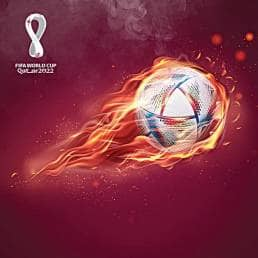



For the entire length of the World Cup, Morocco was happy not to have possession of the ball for long periods of time. Sit back and absorb pressure – that was the plan. Spain and Portugal stumbled on the way, playing into Morocco’s hands, as the two footballing giants kept attacking with ample possession. Morocco solely concentrated on making their few attacks count, and it worked. Croatia, for the most part, adopted a similar plan and succeeded in reaching the semi-finals along with Morocco.
 Read more FIFA 2022 stories here
Read more FIFA 2022 stories here
This World Cup has been barren with regard to emergence of new tactics or formations. No outstanding strategy was on display. What Morocco and Croatia did was to design a game that would cover for their weaknesses, relying instead on fighting spirit and grit.
What was seen was adaptation. Argentina is a case in point.
They started off the tournament with Angel Di Maria, Lautaro Martinez and Lionel Messi in the forward line trying to outmuscle opponents. But their structural foundation looked shaky. The formation didn’t look solid enough and Saudi Arabia made them pay in their first game. Coach Lionel Scaloni was quick to disrupt the model and dropped Di Maria and Lautaro to the bench. He adopted a 4-4-2 formation instead, with just Messi and Julian Alvarez upfront. The new attack looked lighter on paper but was decidedly more effective, even as Argentina turned its fortunes around.
The real proof of this was seen in the quarters when Argentina took on the Netherlands. Messi’s squad kept all the fancy stuff aside and scrapped for every ball, against a Dutch side which itself played a very physical and rough game in sharp contrast to their usual flowing style of football.
Brazil, as usual, was among the tournament favourites with its attacking riches in the form of Neymar Jr, Gabriel Jesus, Rodrygo, Vinicius Jr, Raphinha and Antony. It was a classic case of too many cooks spoiling the broth. Talent overflowed but against a calculative side like Croatia, they came up short. Brazilian coach Tite, unlike Argentina’s Scaloni, failed to adopt a ‘horses for courses’ approach and paid dearly. Maybe, for this particular match, he needed to go for a 4-man midfield by possibly including Fabinho.
Croatia had arguably the best midfield unit in the tournament led by their talisman Luka Modric. Brazil found it tough to go past the Croatian midfield and it took the genius of Neymar to score a goal of great individual brilliance, and yet Croatia beat them in a heart-breaking tie-breaker. On the other hand, Scaloni fielded a fortified midfield against Croatia in the semi-finals, negating the latter’s dominance. It was this kind of quick adaptation that worked in this tournament and not strategies that accommodated all your best players in the XI. Portugal was too late to realise that their best XI was the one that didn’t feature Cristiano Ronaldo.
Also read: FIFA World Cup classics, part 1: Maracanaço and the Phantom of 1950
France was probably the only side that played the squad they wanted throughout without having to tailor their XI according to the opposition. The well-balanced outfit at coach Didier Deschamps’ disposal ensured a relatively smooth passage to the final, with power forward Kylian Mbappe’s searing runs and confident finishing ensuring a clear head-start against any rival. Antoine Griezmann’s revival, this time as a midfielder, striker Oliver Giroud’s precision in front of goal and a solid defensive line up have helped France find all the answers. For the French team management, there was hardly ever a need to come up with an alternative plan. The final against Messi and company may be a little different though.
The World Cup of 1974 saw the emergence of Total Football with Holland’s Johan Cruyff and Germany’s Franz Beckenbauer. The 1950 World Cup laid the foundation for Brazil’s attacking flair, a story that found its culmination with Pele’s 1970 squad and later reignited with Ronaldo’s and Ronaldinho’s 2002 team. The 2010 Spanish squad showed the effectiveness of tiki-taka or short passing. All the Italian teams over the years showed us why a robust defensive chain can be enough to win World Cups. The German teams have nearly always exhibited efficiency and an effective passing game to win multiple championships. However, this edition hasn’t shown us a clear tactical path. It was all about being in the present, bringing flexibility whenever needed and fighting for a favourable result till the very end. Japan showed us how organisation can go a long way in today’s football by beating both Spain and Germany to top its group.
In the end, the traditional powerhouses (Argentina and France) have moved into the final, proving that big match players like Messi and Mbappe can’t be manufactured overnight. They emerge marinated over time in a deep-soaked footballing culture that spans several decades.
Discover the latest Business News, Sensex, and Nifty updates. Obtain Personal Finance insights, tax queries, and expert opinions on Moneycontrol or download the Moneycontrol App to stay updated!
Find the best of Al News in one place, specially curated for you every weekend.
Stay on top of the latest tech trends and biggest startup news.